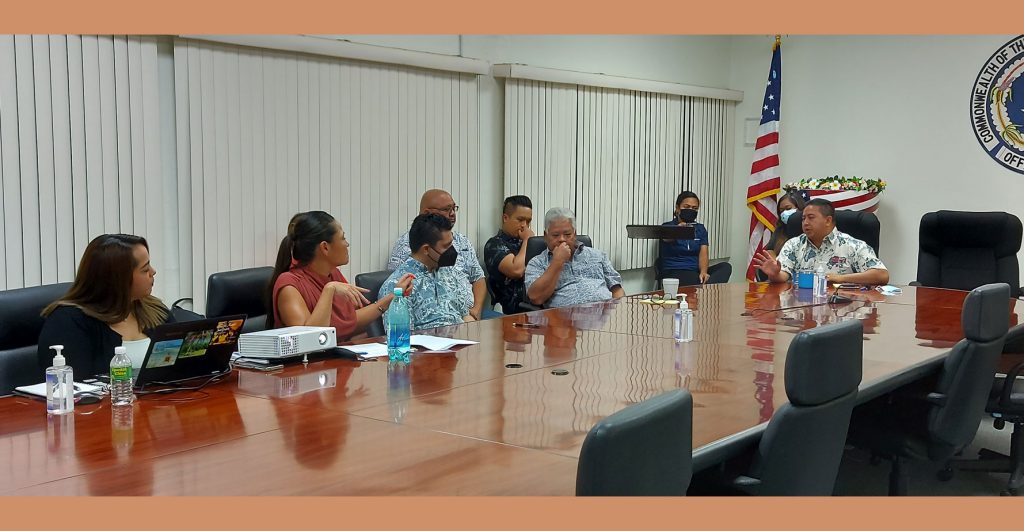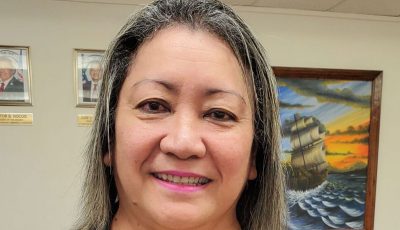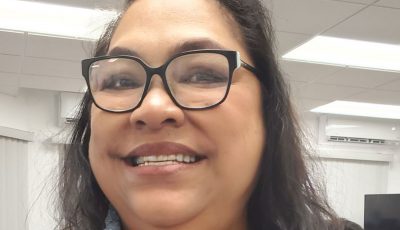Tourism revival plan is OK’d

Discussion take place at the presentation of the Tourism Investment Program by the Tourism Resumption Task Force chaired by Kimberly King-Hinds. (BEA CABRERA)
The Marianas Visitors Authority board approved yesterday the Tourism Investment Program proposal put together by the Tourism Resumption Task Force headed by chair Kimberly King-Hinds after it was introduced and explained to the public at a meeting at the Governor’s Office on Capital Hill.
Called “TRIP” for short, the proposal aims to revive the tourism industry after over a year of stagnation due to the COVID19 pandemic, in a move to bring back livelihood opportunities to the people of the CNMI without compromising the health and safety of the community. It is expected to start in mid-July and the pilot program will run for two months.
By law, MVA has the power to approve and execute the TRIP and, according to board chair Viola Alepuyo, they approved it with one condition. “…We are going to adopt it… with the condition…to make changes based on the recommendations of our…field office or CNMI COVID-19 Task Force because, with the pandemic, things and situations change constantly. If we have community transmission next week, then we would have to revise and adapt and that was the only caveat,” she said. “…TRIP is not set in stone. …We will adopt it but in the event anybody brings up changes with the board, then we can have an emergency meeting in order to amend it to fit the circumstances.”
What is the TRIP program?
According to Kim-Hinds, who is the chairwoman of the Commonwealth Ports Authority, the TRIP program is an offshoot of the tourism resumption blueprint that was put together last year in June by the Office of the Governor, the Governor’s COVID-19 Task Force, and CNMI healthcare officials, which basically allowed for the partial resumption of the tourism industry.
“The flatline of tourist arrivals as a result of the outbreak of COVID-19 has basically resulted in the dramatic and swift loss of tourism arrivals that has led to business closures and widespread employment disruptions, which has impacted the government’s ability to generate revenues. …Fortunately for all of us, the federal government has come for us through the CARES Act and, most recently, the American Rescue Plan Act, but these funds are not going to last forever,” she said.
It has therefore become a race for time to get the CNMI economy back to a sustainable level before the ARPA funds run out, she said. “…The forefront of our consideration was balancing two things—how do we keep vigilant to make the community safe while working toward to an economic self-sustainability before we run out of federal assistance that is bound to expire within two years? …TRIP intends to revive the tourism industry in the CNMI, which is critical in supporting thousands of jobs and families that rely on these jobs to keep the lights on and put food on the table,” she added.
TRIP then is a set of organized plans on how the CNMI will accept tourists, how tourists can enjoy their stay, and how airlines, hotels, and tour operators can jumpstart their own operations. TRIP includes incentives and discounts given to airlines, hotels, tour operators (during the pilot program only) that have been studied and vetted to attract tourists back and ensure that the program will not overrun or compromise the safety of the community.
According to Tourism Resumption Task Force officer Ivan Quichocho, these incentives are not intended for them make money but to ensure they lose less money or at least break even.
-Flights: The CNMI agrees to incentivize flights that will have below 40% load and for ticket prices to be sold at $400 per passenger. Anything above 40% load, carriers won’t need the incentive. To date, there are two carriers that have shown potential in participating and will run two flights a week for an eight-week duration and maintain the ticket price at $400.
-Hybrid quarantine facilities: The first five days of arrival will be spent at a designated quarantine site. The difference between the “Hybrid Quarantine Hotel” from regular quarantine hotel in the CNMI is that tourists can go out of rooms and enjoy the facilities. On Day 1 all passengers will receive a PCR test and all visitors must remain in their rooms. On Day 2 to 4, if the results are negative, visitors will be free to enjoy the facilities that include water parks, access to the beach, restaurants, and local golf course. All hotel staff and workers will also stay in the facilities. Day 5 after a second PCR test with negative result, visitors will leave the hybrid quarantine facility. Both PCR tests are free, covered by TRIP.
-Corridor Hotel: At least two hotels will be tapped as “Corridor Hotels.” TRIP will incentivize these hotels to offer 24-hour service, available rooms, dining accommodations, water sports activities, and must be willing to open with COVID-19 monitoring guidance. TRIP plans to subsidize $150 for a room a day.
-Travel Agency Incentive Program: These are incentives for wholesale and retail travel operators in order to sell and push the CNMI as an ideal travel destination. In order to avail of incentives, operator must be accredited and bear the “Safe Travel Stamp” of the World Travel and Tourism Council.
-Tourist incentives: Aside from the free PCR tests, tourists are given “Travel Buck” that is likened to pocket money for their trip to Saipan, Tinian, and Rota. Each island visited will entitle them to a $500 voucher that they can use for hotel accommodations, food, etc. The more islands they visit, the bigger the “Travel Buck” they will receive from the program.
The pilot program will cost between $8.6 million and $13.2 million. Benefits estimated are between $18.4 million to $20.9 million. According to King-Hinds, the budget for the TRIP will come from the ARPA funding.
“The only source of money right now is ARPA. Obviously, there are legal requirements when you use those funds and that is why we are rolling and having this conversation. Also MVA, will have to properly vet it,” she said.



























